 Robbie Cooper, Immersion, 2008
Robbie Cooper, Immersion, 2008
Last week i came back from Florence completely gutted because i hadn’t seen Snooki. As much as i like the alluring little lady, i was in town for an entirely different reason: the opening of the exhibition Virtual Identities at the Centre for Contemporary Culture Strozzina.
CCCS is part of the Fondazione Palazzo Strozzi which has the mission to give the city of Florence an international contemporary culture varnish. As far as i’m concerned, the initiative works like a charm. I now find myself taking the train to see exhibitions in Florence far more often than to, say, Milan. Each year, CCCS produces a series of thematic exhibitions which blend together recent scientific researches, current societal issues and the big as well as the emerging names of contemporary art.
 Les Liens Invisibles, Seppukoo.com, 2009
Les Liens Invisibles, Seppukoo.com, 2009
The new exhibition, titled Virtual Identities enquires how digital culture is redefining the characteristics and boundaries of our identity, both personal and collective.
Franziska Nori, director of the Centre and curator of the exhibition, has been investigating new media culture for over a decade. You might remember I love you computer virus, the seminal exhibition she curated when she was digitalcraft’s Project Director. Nori started thinking about the Virtual Identities show 8 years ago. 8 years is such a long time in the history of the ‘network culture’ that it compels you to have a look back at what online life was a few years ago. So much has changed. Second Life doesn’t make the headlines of newspapers anymore, and when MySpace does, it never brings any cheerful news for the social networking website. On the other hand, 8 years is not a long enough lapse of time to allow for the temporal distance necessary for a serious critical assessment.
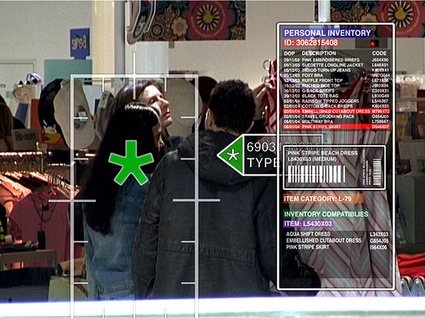 Chris Oakley, Video still from The Catalogue, 2004
Chris Oakley, Video still from The Catalogue, 2004
Virtual Identities is therefore a snapshot of the relationship of man with digital technologies. The crucial role that virtual life takes in our society is naturally embedded into the work of young artists who grew up using the internet on a daily basis but it has also spread into the work of some of the most widely recognised names of contemporary art. That’s why the exhibition will take you from Michael Wolf‘s amazing Paris Street View prints to the facebook suicides offered by the young duo Les Liens Invisibles.
One of the first works you encounter as you enter the show is Immersion, a video in which Robbie Cooper captures the powerful emotions that are manifested on the faces of children and young people interacting with a screen as they play computer games. The camera was incorporated into the monitor displaying the images that captivate the young players. The observer is thus face to face with children who ignore them, enwrapped as they are in the action that takes place on the monitor. We never get to see what they see, only the sounds of the game reaches our ears here and there.
Cooper’s work creates a dual feedback: the players react intensely to the images they see on the screen, whereas we – the observers – react with our own feelings to their powerfully emotional facial expressions that to us, in turn, are just another image on a screen.
 Evan Baden, Katie with LG Chocolate, 2007
Evan Baden, Katie with LG Chocolate, 2007
 Evan Baden, Lila with Nintendo DS, 2007
Evan Baden, Lila with Nintendo DS, 2007
Evan Baden‘s The Illuminati is another example of one-sided exchange. The series focuses on the facial expression of young people whose attention is entirely focused on their digital devices. Their face is bathed in the light emanating from their device, the effect evokes the way light hits the face of the subjects of Georges de La Tour’s paintings. The luminous halo strengthens the impression of an intimacy between the piece of electronics and the teenager holding it, leaving viewers in the position of outsiders.


Although it was not part of the exhibition, i’d like to mention another series in Baden’s portfolio because it shows in a striking way how much the internet has overthrown the boundaries of the personal sphere. For Technically Intimate, Baden tracked the young girls who had posted on the internet intimate photos of themselves. The photographer re-staged the scene, and the encounter between the sexually explicit images and the girly teenage rooms is quite unsettling. In a charming way.
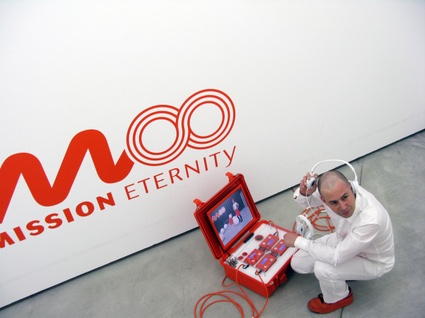 Image etoy.CORPORATION
Image etoy.CORPORATION
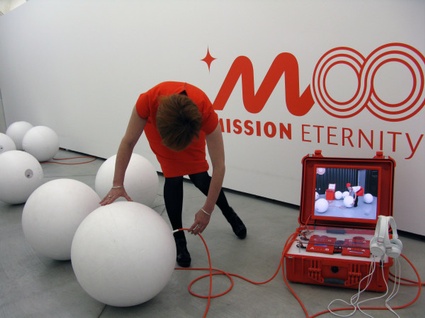 Image etoy.CORPORATION
Image etoy.CORPORATION
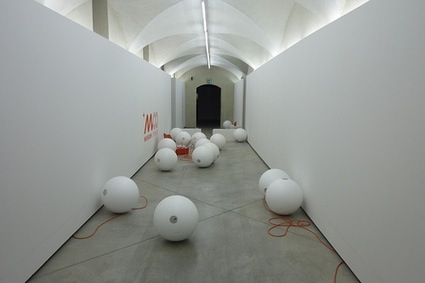
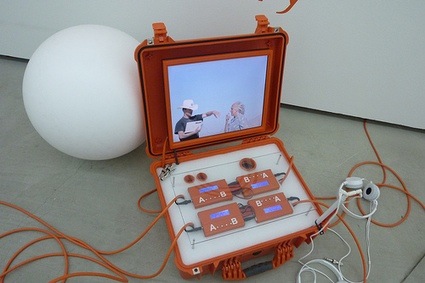
The TAMATAR installation brought me back to more familiar territories. TAMATAR is part of MISSION ETERNITY, a long-term project by etoy.CORPORATION that involves a mobile cemetery tank which allows for the archiving and re-location of the massive body of digital information that up to 1000 M∞ PILOTS leave behind them throughout their life.
TAMATAR (a contraction of the Japanese term * TAMA that refers to spirit or soul and of the word ‘avatar’) are spherical carriers created for the resurrection of dead MISSION ETERNITY PILOTS.
Previously recorded memories of the M∞PILOT are used to detect characteristic elements and to derive behavioural pattern for the TAMATAR. This code is combined with voice recordings and ca. 16 giga bites of data collected by the PILOT, his friends/family and etoy.AGENTS to generate 16 TAMAS*.
In a ritualistic art performance, the TAMAS (software) are uploaded into the 16 TAMATAR (hardware: the spheres acting as the transport layer for digital content). The TAMA-SOFTWARE starts to posses the new bodies. The physical carrier is able to move (roll), to talk with the original voice of the dead person and to make use of telepathy (wireless communication). The simple set of possibilities of expression is the base for complex physical, emotional, intellectual and poetic interaction with living human beings, other TAMATAR (the dead) and technical components (on- and offline).
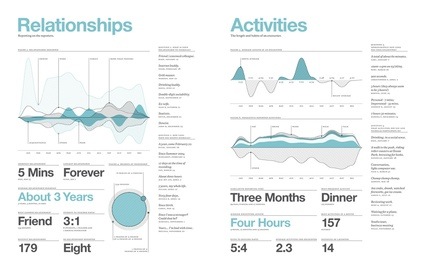 Nicholas Felton, The 2009 Feltron Annual Report
Nicholas Felton, The 2009 Feltron Annual Report
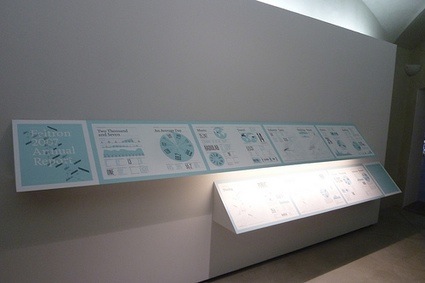 View of the 2009 Feltron Annual Report in the exhibition space
View of the 2009 Feltron Annual Report in the exhibition space
In 2005 Nicholas Felton started to record and document facts and figures regarding his everyday life: how many miles he has flown on planes, how often he visits a museum, how many birthday parties he attends, how often he has been sick, etc. At the end of each year, the navel-gazing data he as collected is turned into a series of statistical diagrams and charts that quantifies his lifestyle. He then publishes the result in a corporation-style report.
This conceptual work of infographics has met with so much attention that Felton has teamed up with Ryan Case to develop Daytum, which allow the aggregation, and visualization of their data. Felton’s work has much in common with the practice of data mining, a strategy used by companies to predict the buying behavior of potential clients. That’s probably the reason why facebook has recently hired Case and Felton.
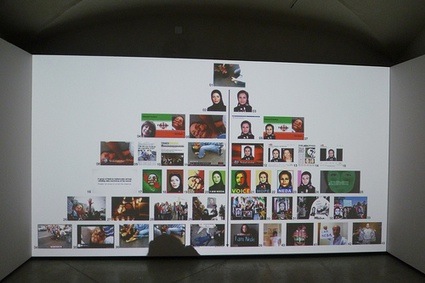 Diana Djeddi, I Am Neda, 2011. View of the exhibition space
Diana Djeddi, I Am Neda, 2011. View of the exhibition space

For Virtual Identities, German-Iranian photojournalist Diana Djeddi was commissioned a new work that traces the tortuous online path that lead from an anonymous video of the murder of a young woman to a global story where all control over content and identity gets lost.
I am Neda charts the story of Neda Agha-Soltan, the woman shot to death in 2009 during the protests in Iran. Her death was recorded by a witness with a mobile phone and published on the internet where it quickly became the emblem of the human rights movement in Iran.
As somebody in the video can be heard shouting the girl’s name, albeit indistinctly, the search to establish her identity led to a tragic error where a basically apolitical and very alive English literature teacher named Neda Soltani was mistakenly identified as the murdered woman via her Facebook profile. Her photo was published by the international media and used as a rallying cry for the revolt against the regime. The Iranian government pressured Neda Soltani to admit that she was an actor and collaborator, forcing the young woman flee the country and travel to Germany where she currently lives as a political refugee.
Neda Soltani’s story is representative of the logic of online communication, based on the rapid sharing of fragments of information that are not always verified causing misinterpretation. Her loss of control over the content that she herself had uploaded to the internet and therefore over her public image reveals the principle of flows of information, images and news that acquire autonomous dynamics that can no longer be controlled as soon as they are made available to the online public. In other words, with a certain degree of public exposure, the individual loses control over the right to the privacy of his or her own image, and with it a part of his or her personal identity.
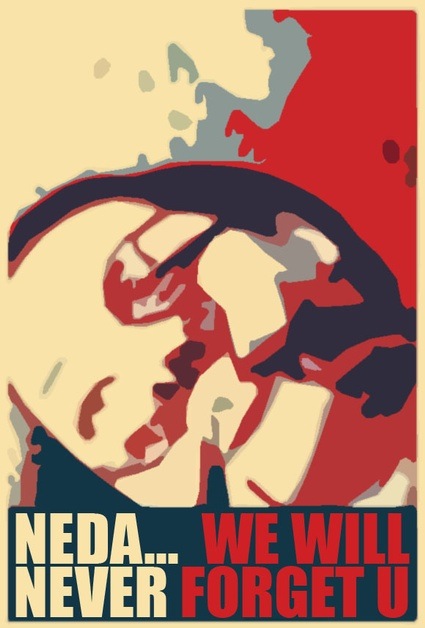 (Image source)
(Image source)
Virtual identities is on view at CCCS-Strozzina in Florence until July 17, 2011.
